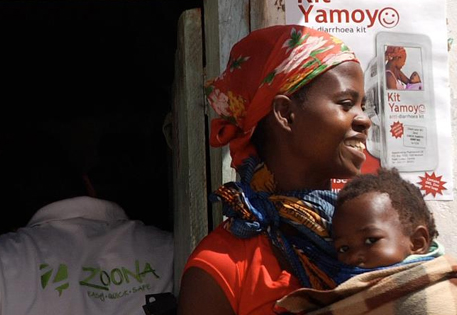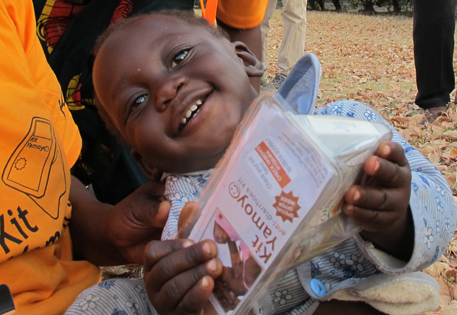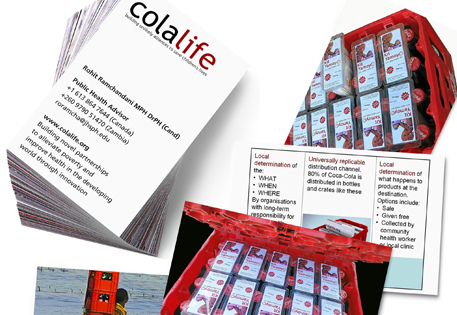Partners for life
« Browse all tipsGetting noticed by Big Business
Our MOO Award winner Simon Berry started his company, ColaLife, as an answer to the question “If Coca-Cola can get everywhere in developing countries, why can’t simple medicines?” Well, the answer is this – harness the power of big brands to help get your own message across.
Using the space within Coca-Cola crates, Simon was able to custom design and ship affordable diarrhoea kits to developing countries – but it took a while to convince the bigger companies to listen.
Here are Simon’s Top Tips for getting noticed by Big Businesses.
Harness social media and get a following
“When I first had this idea, it was the mid eighties and I was working in Zambia on the British Aid programme. We had no phones, no postal service, and no way of sharing the idea. Twenty years later, and along came Facebook! Incredibly, just a few hundred followers saying they like an idea is enough to engage people like the BBC, Coca-Cola and UNICEF.
As Simon Berry I got nowhere, but as an idea with a following, I was listened to because I had power; power to draw people to me and to my idea. Suddenly I was Simon Berry - plus 1000 Facebook supporters. And that means the BBC were interested. Then, with the BBC on board, I was able to get Coca-Cola’s attention….and that’s how the conversation got started.
Make it easy for them to say yes
When you want a big business partner, you have to make it as hassle free for them as possible – like us, and our design. Once we realized what space we had to work with, we focused really hard on making a package for our diarrhoea kits that fitted the space. We started with the packaging and worked backwards. We thought a lot about the packaging and how we can make it multitask – so we turned it into a measuring, storing, mixing and drinking device. And because we had no choice but to start with the packaging and work backwards, it actually made the product better.
So if you want to work with a big brand, think about what you can do with your product to make the idea as painless and attractive as possible for their decision makers.
Pick a big company whose system works for you
Coca-Cola haven’t got a foolproof distribution system. What they do have is a highly desirable product and because of that, people come to them. Coca-Cola lorries don’t go all the way to remote villages in Zambia. They take their product to a district as far as they can take it, and from them on, independent local entrepreneurs take it to where it’s needed. We looked at a lot of models and we thought this one would work – because our product is extremely desirable, affordable, and profitable enough for those independent distributors to think its worth their while.
So do your research – work out what you want and your fiscal limitation. And then see whose system you can easily slip into!
Follow their lead – crowd source your followers
Once you have a following, do what big companies do – and use it. “Lego is a good example,” Simon explains “Years ago, they spent 7 years working on a new range of robotic Lego which you control from your computer. All the Lego fans were waiting eagerly for it, but when it eventually came out, the user group had already reverse engineered the whole thing and created their own version. Lego took note – and now, they involve their users in the development of new products,”
Use the experts among your supporters and social media followers – they are a mechanism to make your ideas better and better. By crowd sourcing expertise, you become more powerful as a group. For example, I couldn’t understand why all rehydration sachets were designed to make up a litre of solution when a child can’t consume that much - So I blogged about it, and it got the attention of the World Health Organisation. Several meetings later, and our partners are manufacturing sachets of 200ml - a glass full.
Use their challenges to improve your product
When you work with a huge brand like Coca-Cola, undoubtedly people will have a lot to say about your product – and they’ll have a lot of questions that you yourself might never have asked.
Instead of thinking of this kind of assault on your idea as negative or too challenging, welcome it instead as a free consultation to make your product as efficient as it could possibly be – with advice from experts in business. They’ll ask why you’re doing something – for example, our original intention was to remove one bottle out of a crate and fill the space with our kits. But when you’re told – rightly - that your idea is going to reduce profitability, you’ll find another way to get the job done. And in our case, a better way – we simply used the empty space between bottles instead. Through being constantly questioned, our ideas have hugely improved.
Simon Berry is the founder of ColaLife, a volunteer run organization that creates and distributes affordable diarrhoea kits to developing countries. Simon is also the winner of the MOO Award – read more about his remarkable business journey here.
New to MOO?
MOO makes life a little less virtual. We help our customers print things like business cards, postcards, flyers and stickers, making it easy for them to share information about themselves or their business in the real world.
Print is simple and wonderful. We love it.
View Our Products







